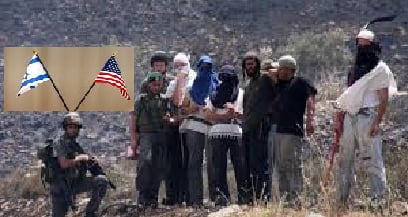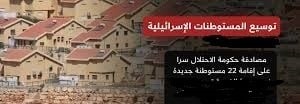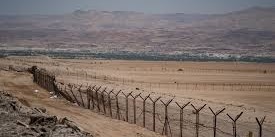By: Madeeha Al-A’raj
Thr National Bureau for Defending the Land and Resisting Settlements stated in its latest weekly report , that there are so many rumors being circulated in the political and media circles on the American Administration’s intention to impose sanctions on Israeli entities, exceed the settlers and some of their entities of Israeli army and police units, particularly, two police units’ violation of human rights. This comes after the announcement of the possibility of imposing sanctions on the ‘Netzah Yehuda Battalion’ in the Israeli army and terrorist settlers, against the backdrop of human rights violations in the West Bank.
These rumors included that officials in the US Administration warned Israel very recently that the nature of the violent practiced by the government, the army and the police against Palestinian citizens requires the United States to impose more sanctions on Far-right activists in Israel, and to expand the sanctions to the ranks of the army and police.
Recently, the US Administration announced its decision to impose sanctions on the head of the racist Lehava Movement, Benzi Gopstein, who is very close to Israeli Minister of National Security, Itamar Ben Gvir, along with other individuals and organizations involved in Jewish violence against Palestinians in the West Bank. This was expected, since the Americans began imposing sanctions on extremist settlers at the beginning of this year.
The US sanctions are based on 2 legal foundations. First, the presidential decree that Biden issued at the beginning of this year regarding extremist settler violence against Palestinians, and allows for the imposition of sanctions on individuals and organizations linked to this phenomenon. Second, the ‘Leahy Law”, which is linked to the name of Democratic Senator Patrick Leahy, and requires restrictions on the transfer of US military aid to individuals involved in systematically targeting human rights.
However, these sanctions are still limited and selective, as they exclude those behind the brutal attacks on Palestinian citizens, such as, Israeli ministers, members of the Knesset, and heads of settlement councils. Those are still far from the danger of imposing sanctions, even though they are the ones who occupy what the American Administration calls violent settlers, such as Bezalel Smotrich, Itamar Ben Gvir, Shlomo Ne’man, Yossi Dagan, and many others. Also, the Regional Councils of the settlements are excluded, although their direct role in practicing violence and terrorism against the Palestinians, especially the Bedouin and herding communities in the Jordan Valley Settlements, for example but not limited to, is clear.
The illegal and even terrorist practices of the ‘Baqaat Herdin Ccouncil’ are taking place in daylight with the knowledge of the occupation army and police, and even in coordination with them. They attack Palestinian citizens, launch armed thugs in organized and planned terrorist operations against them, confiscate their lands and expel them from them and their pastures, and confiscate their cows and sheep through piracy operations, just as the Israeli government does, and don’t return them except for an exorbitant price, and examples on that are many:
On last Dec. 25, settlers from this council seized a herd of cows and took them to the vicinity of the Hamdat settlement, and then summoned the Regional Council inspector to the place, who confiscated 19 cows and kept them in a pre-prepared barn, under the pretext that they were ‘vagrant animals’ under the local law. A week later, the council issued a voucher obligating the owner of the herd to pay NIS 49,000 to free them. Shepherds feared the loss of their sustenance; they paid this huge sum to the local council with the help of Israeli activists and took the herd.
The scene was repeated in last Jan. as settler Uri Cohen told a member of the Daraghmeh family, who was grazing his cows in the field that he could graze his cows in an area near the ‘Brush settlement’. The next day, Cohen himself called the shepherds again and urged them to head towards an area further north. After they moved to the area, they found that the Regional Council inspector was waiting for them, and confiscated 48 cows and put his hand on them, this time under the pretext that they were grazing in a prohibited area. The Regional Council issued a payment voucher worth NIS 143,910 for Daraghmeh’s family to free their animal. After 3 weeks, the same Regional Council detained a herd of sheep and confiscated about 600 of them belonging to the Adayes’ family. The livestock were seized without any prior warning and in an area considered to be the grazing path where the family’s herds have been grazing for decades. The council representatives did not justify the reason for the confiscation and issued payment vouchers worth NIS 150,000. Thee sum was collected and paid to the council in exchange for clearing the herd.
These scenes of violence are repeated in more than one area and place in the West Bank. The luck of the shepherds throughout the Jordan Valley is the same. In mid-April, settlers seized 120 sheep belonging to a citizen of the village of Al-Mughayir, attacked the house and the barn, and 20 neighboring houses, and burned a car in the presence of occupation army soldiers. Later, the village shepherds found 20 lamps dead with rubber bullets. Settlers came in military clothing and others civil. They lie among the olive trees, checking the identities of the Palestinian shepherds, threatening them with weapons, and seizing their herds, as is also the case in the Kafr Malek village.
The assault, threats, and robbery of sheep come from hilltop gangs to reduce the grazing areas used by Palestinians. The goal is clear: displacement, ethnic cleansing, and control of the largest area of land with the smallest number of Palestinian residents, which explains the displacement of the shepherds’ communities in the area located east of Alon Street, where the “Rimonim” and “Kochav Hashahar” settlements are located and the settlement outposts, which are spreading in that area like mushrooms. This violence doubled after October 7 at the hands of the settlers, whom Itamar Ben Gvir armed and Smotrich financed their crimes, until it reached the point of displacing about 18 herders’ communities in the West Bank, including 5 communities in traditional grazing areas to the east of the villages of Al-Mughayir and Kafr Malek.
As settlers realize that the occupation government provides them with a dome of political protection, their terrorist attacks on Palestinian villages and towns and Bedouin communities have continued. They launched an armed attack on the village of Al-Sawiya, south of Nablus, which led to the martyrdom of the Qaryut ambulance driver, Moh’d Awadallah Musa, 50, who was carrying out humanitarian work to treat wounded people from the village, and two were injured by live bullets during that attack, which was carried out by Terrorist settlers from the “Eli” settlement established on the lands of the villages of Qaryut, Al-Sawiya, and Al-Lubban Al-Sharqiya.
The village of Burqa in the Ramallah and Al-Bireh Governorate was also subjected to a terrorist attack by settlers, which resulted in 6 injuries with live bullets, one seriously in the chest, 2 moderate injuries in the chest as well, the same in the lower extremities, a minor injury in the upper extremities, and the burning of a sheep barn and a barn containing more than 250 sheep, belonging to the citizen Nizam Ali Maatan. This village of Burqa, as everyone knows, had experienced difficult suffering in less than a year ago when it was subjected to a brutal attack by herds of settlers, in which the young man Qusay Jamal Maatan, 19 was martyred.
Back to the sanctions imposed by the American administration on settlers and settlement entities or providing support to settlers who practice violence and terrorism against the Palestinians, the motives behind this are still ambiguous, selective, and ineffective, affecting distant parties and far from the goal. In addition, they are subject to bargaining with the leaders of the occupying state, who do not like to see the American Administration participating, even remotely, in questioning and holding accountable those who stand behind these attacks, those who direct, lead them, and those who finance them. It comes to camouflage the anti-Palestinian positions in the United Nations, as happened recently in the UN Security Council, and to camouflage the unlimited support and exceptional aid that this Administration provides to the occupying state, its army and its police.
This support, which in general average, over the years, is equivalent to 3% of the general state budget, 20% of the general security budget, 40% of the army budget, 100% of the US arms purchases budget. In any case, the question remains regarding the nature of these sanctions and the extent of their impact on the behavior of the settlers and the behavior of the occupation army and police, especially in light of what is being circulated in political and media circles about the possibility of postponing or even canceling the imposition of sanctions on the ‘Netzah Yehuda Brigade’, which is known for its abnormal behavior, according to what emerged at the end of the week regarding a letter sent by the US Secretary of State to the Speaker of the House of Representatives in the US Congress.
On the other hand, it is reported that Minister Smotrich recently issued instructions to various government ministries to begin providing budgets and services to 68 illegal settlement outposts in the West Bank in implementation of the Cabinet decision issued in Feb. 2023, and the coalition agreements with Likud as well. Accordingly, the various authorities will deal with these illegal settlement outposts as if they were legal for the purposes of budgets and services and refrain from implementing demolition orders in them. The list of the 68 outposts has not yet been published and it is difficult to know which outposts are in question. Peace Now’s cautious assessment is that these are mostly relatively old outposts, but the list may also include newly established outposts.
As for the settlement activities of the occupation government, the Israeli Ministry of Housing published a tender to build a new settlement that includes more than 1,446 settlement units on the lands of Beit Safafa and Sur Baher in East Jerusalem. It is the “Lower Canal” settlement, which is a new settlement approved by the occupation authorities on the first of last January, and the tender for construction was published on this 16 April. According to the “B’Tselem” organization, such a short time between the date of authorization and the publication of the tender is unprecedented, from a political standpoint. ‘B’Tselem’ added that the construction of the new settlement comes within the framework of a strategic plan that will severely affect the possibility of Palestinian urban connectivity in East Jerusalem, in practical terms, the construction of the settlement closes the last remaining corridor to connect Beit Safafa and Sur Baher to other parts of East Jerusalem.
List of Israeli Assaults over the Last Week Documented by the National Bureau:
Jerusalem:
- Heading toward the city of Jerusalem, in preparation for collecting the ‘offerings’ at the point closest to Al-Aqsa, in an attempt to slaughter them inside on the eve of the Jewish Passover.
- Submitting an official request to the Israeli police to allow settlers to enter Al-Aqsa and slaughter offerings’ inside it. The “Temple Mount Administration” circulated its calls through various communication platforms and websites, and asked its supporters to gather at the Moroccan Gate, to demand that they be allowed to storm Al-Aqsa. The groups and organizations of the alleged Temple had offered financial rewards to the settlers who would attempt or succeed in slaughtering the sacrifices, ranging between NIS 50,000 – 700,000 ‘depending on the place of slaughter’.
Hebron:
- Storming the Ibrahimi Mosque and the Old City of Hebron amid strict military measures imposed by the occupation forces on citizens in those areas. They organized provocative marches that started from settlements and outposts established on citizens’ lands in the city and outside it.
Bethlehem:
- Detaining the young man, Baha’ Ali Salah, in his 20s, and his agricultural tractor while he was plowing his land located between the Al-Shami and Al-Abyar valleys, south of the town of Al-Khader, they also stormed the Suleiman Pools area, specifically the vicinity of the third pond in the Al-Atan area.
Ramallah:
- Attacking a building materials company east of the town of Turmus-Ayya, causing material damage to vehicles in the vicinity of the company. Others, accompanied by the occupation army, stormed the home of citizen Eid Fazza Kaabneh near the “Karmlo” Junction, east of Taybeh, and stole 2 cars, flashlights, and solar energy equipment, and destroyed houses’ furniture.
- Settlers closed the Al-Marajat Road between the Ramallah and Jericho governorates with their vehicles, and prevented citizens’ vehicles from passing.
Nablus:
- Firing live bullets at citizens’ homes in the town of Sebastia, causing damage to a number of them, but no casualties among citizens were reported.
Salfeet:
- Attacking vehicle of the citizen Moh’d Adham Al-Deek while passing near the town of Derastiya.
- Uprooting about 70 trees belonging to the citizen Hisham Abdel Razzaq Rayan from the town of Qarawat Bani Hassan, which are olive trees, grapes and almond trees, in the “Khallet Abu Zeid” area west of the town and stole them, as well as taking down the barbed wire surrounding the ground.
Qalqilia:
- Opening fire from the Havat Gilad settlement towards the village of Faratha. It is known that the aforementioned settlement was established on the lands of the villages and towns of Kafr Qaddum, Jit, Sarah, Imatin, and Farata, east of Qalqilya.
Jordan Valley:
- Attacking the Ein al-Hilweh area in the northern Jordan Valley, closed the road leading to the Maleh Junction, carried out orgies and threw stones at passing vehicles.
- Storming the house of the citizen, Ayed Musa Ka’bneh from the “Ras Ein al-Auja” community and photographed the livestock and the house, claiming that the livestock were stolen from them.
 المكتب الوطني للدفاع عن الارض ومقاومة الاستيطان منظمة التحرير الفلسطينية
المكتب الوطني للدفاع عن الارض ومقاومة الاستيطان منظمة التحرير الفلسطينية




